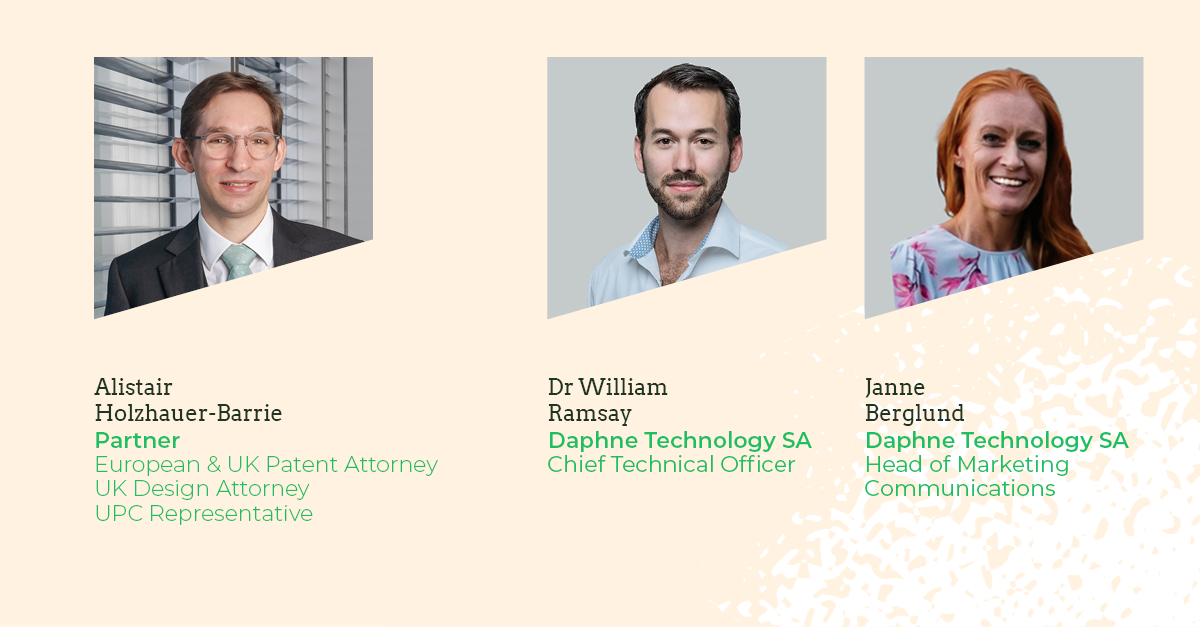
Alistair Holzhauer-Barrie in conversation with Dr William Ramsay and Janne Berglund
GJE works directly with companies across the UK, Europe and further afield. Some have a long history behind them, while others are young and exist in a vibrant startup community. Young companies often have a dual focus in their early years of developing the core business while also securing investment to fund that development. To highlight achievements and trials young companies go through, GJE partner Alistair Holzhauer-Barrie was privileged to interview Dr William Ramsay and Janne Berglund at Swiss-based client Daphne Technology SA, founded in 2018.
Thank you very much for talking with us today. Would you be able to introduce yourselves and tell us a little bit about Daphne and the Daphne team, please?

I am head of marketing communications and branding at our Norwegian subsidiary in Oslo. I have been with Daphne for almost four years.

I am the chief technical officer at Daphne, and I started with Daphne in 2019 when [Founder and CEO] Mario was starting the company.
Daphne Technology is a Swiss climate deep-tech company at the forefront of addressing one of the most pressing challenges of our time – reducing greenhouse gas emissions in hard-to-decarbonise industries.
Our mission is centred around developing and scaling innovative technologies that significantly contribute to global methane slip reduction and greenhouse gas emissions, for the broader fight against global warming.
At Daphne, we have about 30 people. The team includes people who are passionate about environmental science and have engineering capabilities and expertise in technology and science. Everyone shares the goal of being committed to sustainability and technological innovation, which has certainly helped us become a leader in climate-tech development.
We have been able to attract support from industrial leaders like Shell Ventures, Saudi Aramco Energy Ventures and J.P. Morgan, not just for the work we are doing at Daphne, but also for the team behind it.
Would you be able to tell us about some of the biggest recent developments in the company?
2023 was a transformative year for Daphne Technology, marked by several advancements and scale-up efforts. We had three pivotal developments in the company.
A significant development was the installation of phase one of our SlipPure™ methane abatement technology on the [Liquified Natural Gas] LNG carrier, Maran Gas Chios. In collaboration with major maritime industry players, this project highlights our role in focusing on greener practices in the maritime industry.
This was a big a big step for us.
SlipPure™ has also been awarded Approval in Principle (AiP) both from DNV and Lloyd´s Register. They were quite pivotal in being able to help us advance SlipPure™. Related to that, we have another product that we have developed at Daphne called PureMetrics™, which accurately measures greenhouse gas emissions from point sources of combustion [to provide “real-time emission reports” and “establish an accurate baseline for” operators]. So, in addition to installing SlipPure™, we also installed PureMetrics™, again with the Approval in Principle from Lloyd’s Register.
On a business development front, we expanded into the United States. We launched a US subsidiary in Houston, Texas, to lead the charge in reducing methane. This move aligns with the stringent North American methane regulations and positions us strategically in the heart of the energy sector’s transformation.
In 2023, Daphne Technology was honoured with winning the prestigious Deep-Tech/Life Science Award at the 25th edition of the Swiss Economic Forum. Daphne’s commitment to developing sustainable solutions to combat emissions and our innovative products stood out among the finalists, securing this recognition.
Another highlight was the selection of PureMetrics™ as a finalist in the Standardised Data Innovation Challenge (SDIC). This competition brought together 70 participants from around the world. In the award ceremony, Daphne Technology was honoured with a joint third-place recognition in the challenge.
In August 2023, Mario was recognised as one of Switzerland’s Top 100 Digital Shapers of 2023. This prestigious recognition is a testament to Mario’s exceptional contributions to the world of technology and innovation. He is one of only nine individuals recognised in the prestigious Nature Techies category, highlighting not only his visionary leadership but also the immense impact of his work in advancing sustainability through technological innovation.
At the end of the year, Daphne Technology was one of the few companies selected to showcase at COP28, where we presented our cutting-edge solutions in the Swiss Startup Village of COP28.
And what would you say distinguishes Daphne from your competition?
The biggest differentiator for us is our focus on reducing methane emissions.
The emphasis on methane is crucial due to its significantly higher global warming potential compared to carbon dioxide. While CO2 is more abundant in the atmosphere, methane is over 25 times more potent in trapping heat over a 100-year period. This makes it a critical target in the short-term fight against climate change.
By addressing methane emissions, we can make an immediate and substantial impact on global warming. This is especially important in industries like shipping and energy, where methane slip – the release of unburned methane into the atmosphere – is a significant issue due to the transition to LNG fuels. Our technologies, such as SlipPure™, are designed to effectively reduce methane emissions, thereby contributing significantly to the reduction of the overall greenhouse effect and aiding in the urgent battle against climate change.
You’ve touched on this already, but what are your upcoming goals and what are your plans for growth?
We aim to commercially deploy our three groundbreaking products: PureMetrics™, SlipPure™, and SulPure®, which convert emissions of, for example, hydrogen sulphide into value-added products like ammonium sulphate.
Over the years, we have done a lot of technological development, and now we are getting into the scale-up phase with commercial deployment. Much of the work from 2023 is now transitioning into deployment of PureMetrics™, SlipPure™, and SulPure®.
As part of our expansion into the US, a goal for 2024 is to expand into other hard-to-abate industries. At Daphne, we have always had an initial focus on the maritime industry and being able to reduce emissions, particularly methane, in the last several years, but now that we have initiatives like the US Inflation Reduction Act, even from the [EU Emissions Trading System] EU ETS more for the marine industry. This is where we would like to grow in 2024 and onwards.
So that’s looking at growth in the future. Where has your growth come from in the past?
It is certainly a combination of the team and help from others. A lot of our growth is obviously from technological innovation. The work, engineering effort, brainstorming and ideas behind all of our products are what has originally driven our growth; but as good as an idea is and as good as your execution is, you do need to have good and strategic partnerships with industry players. For example, our Maran Gas Chios project would not have been able to move forward without everyone we work with, so having strategic collaborations in addition to the technological innovations that drive growth, particularly in an early-stage company.
We also have some global recognition and support from European Union funding agencies and approvals from legislative bodies. These all are critical steps to help develop and move to the next step.
With that commercial side of the business in mind, could you tell us a bit about your Intellectual Property (IP) strategy?
Currently, we are focused on filing patent applications that protect our developments and filing these patents in a way that allows other companies to license them. There are some very important, if not quite subtle, differences in writing patent applications with the view that they will be licensed at some point in the future. We also focus on filing internationally, as we work in industries that span the globe.
Trade marks, of course, form an important part of our intellectual property, and so we have a strategy to be able to trade mark product names like SlipPure™, and SulPure® and PureMetrics™. While we do not trade mark just “Pure”, the “Pure” is becoming more associated with Daphne every day.
And how has your approach to IP changed as the business has developed?
When we first started, we were really just filing patent applications. It was a little bit like the more patents we had, the more “perceived” protection we had. Now, in more recent years, we have changed to being focused on generating licensable IP.
What do you know now about IP that you wish you had known earlier?
IP is a long strategy. You have to think about the several-year time frame. Patent applications and trade marks take time, so you need to plan those costs over a long period of time.
You also need to think that, as a global company, you have to consider what the world view will be in 10 or 15 years, and it is certainly a challenge. That is something that maybe was not appreciated by everyone when we first started.
That’s very interesting. Having been through that learning process, how do you ensure that, as a company of Daphne’s size, you maximise the value of your IP portfolio?
First, it is related to identifying and protecting our IP assets. There is certainly a point where you must sit down and identify all of your intellectual property. You might think that everything is protected, but there might be something that is not protected or is worth protecting.
Yearly reviews with GJE have helped us identify all potential IP assets at Daphne, from patents to trade marks to trade secrets. Internally, we have quarterly “IP Capture” sessions to identify if our developments are worthy of IP protection. Every quarter, this is a dedicated time to sit down and discuss with people who are really doing the development to identify the most recent developments. Even if they are incremental, they are still worthy of IP protection.
All of these get wrapped up into a strategic IP plan that gets reviewed annually. It gives you a road map to be able to protect your IP, and determine which IP assets are core to the company’s business objectives and focusing resources on protecting and monetizing those assets effectively.
You’ve clearly had success over the last few years both on the commercial side and on the fundraising side. How does your IP support investment in Daphne and fundraising rounds?
Without question, during a due diligence with a potential investor, you know they come with a laundry list of everything they need to go through to evaluate the company. Without question, there will be a section of that process, which is an evaluation of the company’s IP. Of course, there is also the commercial side of things, but there is certainly an interest in the IP. As well as the exercise to identify “Do you have IP?”, if you have patents, trade marks, or copyright, they will look into what activities you have done to look at your strategy for IP. How do you protect your innovations? How do you enforce your IP against infringers? Do you have an IP strategy document? Do you have trusted legal counsel? Do you have someone in your company actively looking into this? These things are important. If you have all of these things, it can seem like a checkbox exercise where your investor is happy to tick those boxes and move on to the next part of the due diligence. However, if you don’t have these in place, it will be a painful exercise during fundraising.
Particularly if we are talking about an early-stage company, lots of your investors are really investing in the idea or the technology itself in addition to the team that is going to do it. So, if they know the key is the idea of the technologies, then there has to be some type of protection behind that and show that the company’s actually been thinking about it. Certainly, for all of our fundraising efforts, our devotion to our intellectual property has helped with those investments.
I think you’ve effectively answered this already, but do you feel the Daphne IP portfolio and strategy have supported investment?
Certainly, yes. As a technology company, we must have an IP portfolio, and it’s important to demonstrate that to potential investors.
We provide all the documentation, and the potential investors are very happy to see all of our activities and the fact that there is a plan. I think that is one of the biggest things; it is easy enough to show all the things we have done, but when we show that these are the things we are going to do, that is where the interest is.
From our side, it’s certainly nice to hear that the IP side of things has helped support investment. Getting into specifics, how do you demonstrate the value of your IP to investors?
Certainly, one of the things that is important for investors is the monetisation strategy. We have to outline how we intend to monetise our IP, including licensing agreements and partnerships. It is important to show investors how you plan to generate income from your IP portfolio.
Having track records and milestones is when you can show the patents that have been approved, particularly in different countries, so having a patent be approved in the US vs. Canada vs. Hong Kong vs. Switzerland. Being able to show that a particular patent family has been accepted in different countries is certainly of value to investors, as well as to the management of the IP portfolio both on the company side and also to the counsel they work with.
And have questions from investors ever informed or led you to change your IP strategy?
Overall strategy, no, but some questions during due diligence have certainly made us wary to ensure that we have good protection over our IP (and that we know how to enforce our IP rights). There are certainly little things and questions that will influence our IP strategy, but overall change, not so much.
Thank you. Moving on to our last question, what is one thing you feel it is important for investors to know about IP?
Let’s say you are an early-stage company; for an investor, if you are an angel investor or just early stage, stop asking for an FTO for the Freedom To Operate report, particularly for a company that is very, very fresh, in seed stage or just getting going. For one, they are quite expensive documents to be able to generate, and they are just giving an opinion on the future risk that a company might step on someone’s toes.
What the investor wants to see is that there is going to be no risk; the company is pursuing patents or is working on things that are going to be fine. There may be a hidden implication that the company is doing their patents or other IP in an area that is not particularly interesting or one that is not particularly populated. Oppositely, you can have an FTO report that actually says the risk to the company is very high, which might signal that the company is working in a very active area and that you have lots of companies filing lots of patent applications. That is probably a good indication that there is some commercial reasoning behind doing this.
Instead of asking for an FTO, ask for the company’s IP strategy report. Chances are the company has just barely submitted their first patent (which they should have done), the one thing that is protecting what the company is going to be built on. If you are an investor, see if the company has considered the next steps; ask: What’s next? What is your next patent going to be on? What are you going to be doing around trade marks? Do you have trade secrets? How are you watching what other companies are developing? Those show that the company you are about to invest in is really considering this, not just saying, “We got the patent; now we are done”.

